It does not matter whether you use macOS or Windows 10. It’s just a matter of time until your device will refuse to start, which could happen for many reasons, including (and not limited to) file corruption, hardware failure, and buggy update. If the unexpected happens with an Apple computer, you can use a macOS bootable USB with the installation media to repair it.
How to make a bootable El Capitan Installer. Download and keep a copy of the ‘Install OS X El Capitan’ App. (Download from App store but make a copy of it before you install it as the Apple Installer deletes it after you use it.) Put it in your ‘Applications’ folder. Format your blank USB (8GB is a good size) as Apple OS X Extended. The El Capitan installer file came down to my Applications folder without problem, but multiple repeat attempts to create a bootable USB (16gb) drive using Diskmaker X 5 has failed. The program appears to go through all the steps, but finally the USB drive is never findable as a bootable drive.
This is one of the main reasons you should consider making a macOS bootable USB when your device is working properly. However, if none of your devices (MacBook, MacBook Air, MacBook Pro, iMac, Mac Pro, or Mac Mini) aren’t working when you need them the most, then you can use a PC to rescue your Apple device. You can use a Windows 10, Windows 8.1, or Windows 7 device to quickly create a USB bootable installation media to reinstall macOS Catalina or Big Sur on your Mac.
Download: OS X El Capitan This will be downloaded as a disk image named InstallMacOSX.dmg. On a Mac that is compatible with El Capitan, open the disk image and run the installer within, named InstallMacOSX.pkg. It will install an app named Install OS X El Capitan into your Applications folder. If you have problems creating the bootable media, you can get a USB flash drive that comes with macOS Sierra, El Capitan, Catalina, etc., on it with the link mentioned below. (I haven’t tried it personally, but it’s worth the try if nothing works.).
In this guide, you’ll learn the steps to create a macOS Catalina bootable USB installation on Windows 10, which you can use to reinstall or upgrade the Apple OS.
Requirements
Before proceeding, you’ll need the following:
- Broken Mac computer running macOS (version 10.12, 11, or later).
- A trial copy of the TransMac software.
- One high-quality USB flash drive with 16GB of storage.
- Copy of macOS (DMG file).
El Capitan Boot Disk
Create macOS bootable USB installation media
To create a bootable USB drive with macOS, use these steps:
Macbook Usb Boot Drive
Download and install TransMac on the Windows 10 device.
Quick note: This is a paid software, but it gives you a 15-day trial, which is more than enough time. (If this works for you and you want to support the developer, you can purchase the full version.)Connect the USB flash drive. (If you have any data on the flash drive, remember to make a backup, as everything on it will be erased.)
Right-click the TransMac app and select the Run as administrator option.
Click the Run button. (If you’re using the trial version, wait 15 seconds.)
Right-click the USB flash drive, select the Format Disk for Mac option from the left navigation pane.
Quick note: You want to do this before creating the bootable media because there is a good chance that the drive was formatted using a Windows device. If this is the case, the chances are that it’s using an MBR partition, and the USB drive needs a GPT partition to work on a Mac.Click the Yes button to format the drive on the warning message.
Confirm a name for the drive. For example, “macOS bootable USB.”
Click the OK button.
Click the Yes button.
Click the OK button.
Right-click the USB flash drive and select the Restore with Disk Image option from the left navigation pane.
Click the Yes button to confirm the erase of the USB flash drive data.
Click the browse button on the right.
Select the .dmg file with the macOS installation files.
Click the Open button.
Click the OK button.
Click the Yes button.
Once you complete the steps, you can now insert the USB flash drive on your Mac computer to install, reinstall, or upgrade the operating system to the latest macOS version, which can be Sierra, Catalina, Big Sur, or higher.
Create a GPT partition on USB flash drive
If the USB flash drive is not working with TransMac, it could still be a partition problem. In this case, you may need to redo the entire process again. However, this time you should use the following steps to use the Diskpart command-line utility on Windows 10 to create the appropriate GPT partition, and then follow the above instructions.

To create a GPT partition on a removable drive, use these steps:
Download macOS Monterey. MacOS Monterey (Version 12) is the Eighteenth. Mac os el capitan download.
Bootable Usb El Capitan Disk Utility
Open Start.
Search for Command Prompt, right-click the top result, and select the Run as an administrator option.
Type the
diskpartcommand and press Enter.Enter the
list diskcommand to view all drives connected to your computer and press Enter.Type the
select diskcommand followed the number assigned for the USB flash drive (for example,select disk 4), and press Enter.Enter the
cleancommand and press Enter.Is there any possible way I can run an Android emulator on my Mac Book Pro with M1 chip as of now? I tried iMazing but the specific app I want to launch with it simply will not. All other emulators like BlueStacks, Nox Player, KO Player will also not run/install. Run Android Emulator On Mac M1 Download There's little else we can say: The M1 hardware is fantastic and higher tiers are on the way promising even better performance. But what we have is already efficient, powerful, and gives us a mainstream AArch64 device that isn't Android. Android Emulator For Mac Run Android Apps On Mac. Android emulators are like software’s, which can install android OS on your Mac systems. Now there is no need to have a look at your phone repeatedly and get distracted. Once it is successfully installed on your computers, you can enjoy android apps on your systems now. Mac run android emulator. I will show you how to run Online Android Emulator & Run Android Apps on Browser - PC/Mac Link of apk online: 👉👉👉. Setup Android Emulator on Mac OS X. The purpose of this section is to guide you to create in your development environment an Android emulator. Android emulators are managed through a UI called AVD Manager. AVD Manager has a nice interface when started from Android Studio. Start Android Studio app, then create a blank project.
Type the
convert GPTcommand and press Enter.Enter the
create partition primarycommand and press Enter to complete the process.
Once you formatted the USB flash drive with a GPT partition, you can use the instructions mentioned above to use TransMac to create a bootable media, but this time skip steps No. 5 through 10 and continue on step 11.
Bootable Usb El Capitan Disk Utility
Transmac Bootable Usb El Capitan
After the process completes, which can take up to an hour, connect the USB flash drive and power on your Mac holding down the Option key, select the USB drive to begin installing macOS.
Bootable Usb El Capitan Not Working
Make Usb Bootable El Capitan

If you have problems creating the bootable media, you can get a USB flash drive that comes with macOS Sierra, El Capitan, Catalina, etc., on it with the link mentioned below. (I haven’t tried it personally, but it’s worth the try if nothing works.)